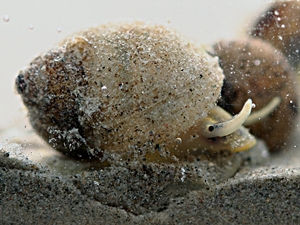Gravel Snails (Lithoglyphidae)
Gravel Snails (Lithoglyphinae)
 Systematics of Gastropoda: Clade Caenogastropoda: Lithoglyphidae.
Systematics of Gastropoda: Clade Caenogastropoda: Lithoglyphidae.
Gravel Snail - Lithoglyphus naticoides (C. Pfeiffer 1828)

Gravel snail (Lithoglyphus naticoides) from Upper Austria (Ri-
ver Danube between Plesching and Steyregg).
Picture: Jan Steger (Source). |
|
Description: The gravel snail has a bulbous shell with a strong wall
coloured a brownish grey green. The apertural whorl dominates the whole spire.
The animal itself has a characteristically broad foot. Males are often smaller
than females. The animal is coloured dark grey in its upper part and lighter
grey on the bottom. The body is covered in golden yellow dots and spots.
Dimensions: H: 7 - 10 mm; W: 7 - 10 mm; N: 4½ - 5.
(Abbreviations).
Habitat and Distribution: The gravel snail lives
in slow flowing rivers. They can be found on firm
muddy ground, on stones and on wood.
Lithoglyphus naticoides needs a high content of oxygen and calcium carbonate
in the water.
The gravel snail originally came from tributaries of the Black Sea. At least
since the Pleistocene it has been found in the Danube river, where it spread as
far west as Regensburg. In the Neolithic era, gravel snail shells were used for
ornamental purposes.
Only since 1883 gravel snails have also been introduced by ship into the North
of Central Europe, in the rivers Rhine and Elbe, as well as in the Baltic
rivers.
Threat Situation: Since 1960 the species is declining fast in central
European waters because of water pollution. In Saxony-Anhalt and
Baden-Württemberg, it is endangered (EN), in the rest of Germany it is
classified as vulnerable (VU). In some places, though, the populations are
recovering (see also:  IUCN Threat Categories).
IUCN Threat Categories).
 Francisco Welter-Schultes:
Lithoglyphus naticoides species homepage.
Francisco Welter-Schultes:
Lithoglyphus naticoides species homepage.
 Molluscs of Central Europe:
Lithoglyphus naticoides.
Molluscs of Central Europe:
Lithoglyphus naticoides.
 Vollrath Wiese:
Lithoglyphus naticoides, with pictures.
Vollrath Wiese:
Lithoglyphus naticoides, with pictures.
 Fechter,
R.; Falkner, G. (1990): "Weichtiere";
p. 126, 127 (1-2).
Fechter,
R.; Falkner, G. (1990): "Weichtiere";
p. 126, 127 (1-2).
 Fischer,
W.: "Beiträge zur Kenntnis der Molluskenfauna Österreichs XXVII. Lithoglyphus
naticoides (C. Pfeiffer 1828)
- oder wie aus einem Inländer ein Zuwanderer wurde". Nachr. Bl. d. E. Vorarlb.
Mal. Ges., 19, p. 27 ff.
Fischer,
W.: "Beiträge zur Kenntnis der Molluskenfauna Österreichs XXVII. Lithoglyphus
naticoides (C. Pfeiffer 1828)
- oder wie aus einem Inländer ein Zuwanderer wurde". Nachr. Bl. d. E. Vorarlb.
Mal. Ges., 19, p. 27 ff.
![]() Family Hydrobiidae
Family Hydrobiidae![]()
![]() Unterfamilie
Belgrandiellinae
Unterfamilie
Belgrandiellinae![]()
![]() Belgrandiella
Belgrandiella![]()
![]() Graziana
Graziana![]()
![]() Unterfamilie
Horatiinae
Unterfamilie
Horatiinae![]()
![]() Sadleriana
Sadleriana![]()
![]() Unterfamilie
Hydrobiinae
Unterfamilie
Hydrobiinae![]()
![]() Peringia
(Mudflat snails)
Peringia
(Mudflat snails)![]()
![]() Unterfamilie Pyrgulinae
Unterfamilie Pyrgulinae![]()
![]() Pyrgula
Pyrgula![]() Family
Bythinellidae
Family
Bythinellidae![]()
![]() Bythinella
Bythinella![]() Family Moitessieridae
Family Moitessieridae![]()
![]() Bythiospeum
Bythiospeum![]() Family
Amnicolidae
Family
Amnicolidae![]()
![]() Marstoniopsis
Marstoniopsis![]() Family
Lithoglyphidae
Family
Lithoglyphidae![]()
![]() Lithoglyphus
Lithoglyphus![]() Family Tateidae
Family Tateidae![]()
![]() Potamopyrgus
Potamopyrgus![]() Family Emmericiidae
Family Emmericiidae![]()
![]() Emmericia
Emmericia![]() Family
Bithyniidae
Family
Bithyniidae![]()
![]() Bithynia
Bithynia